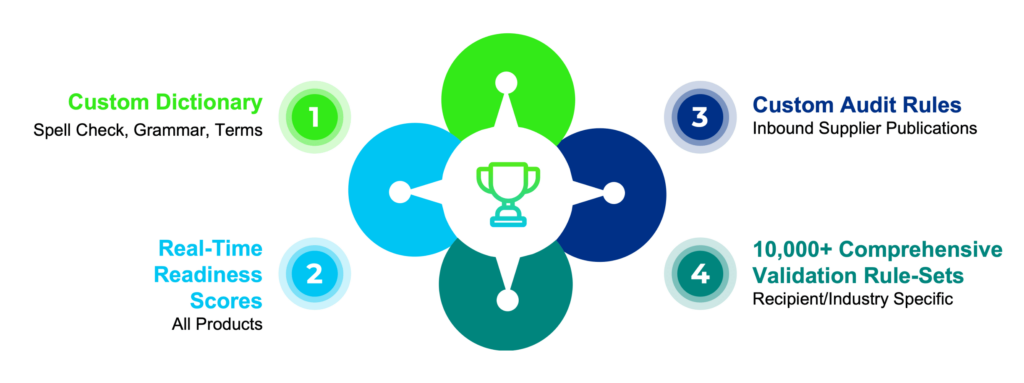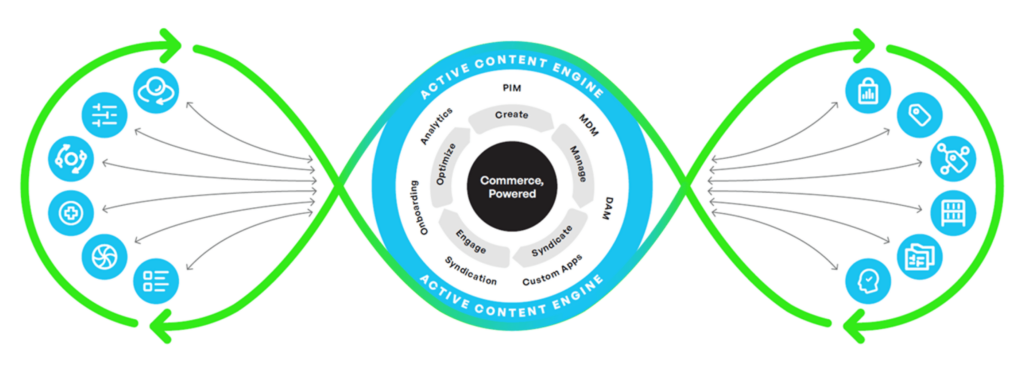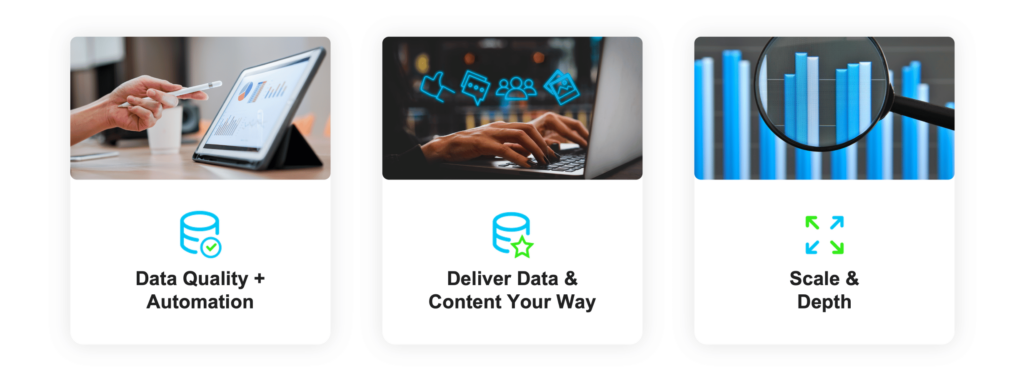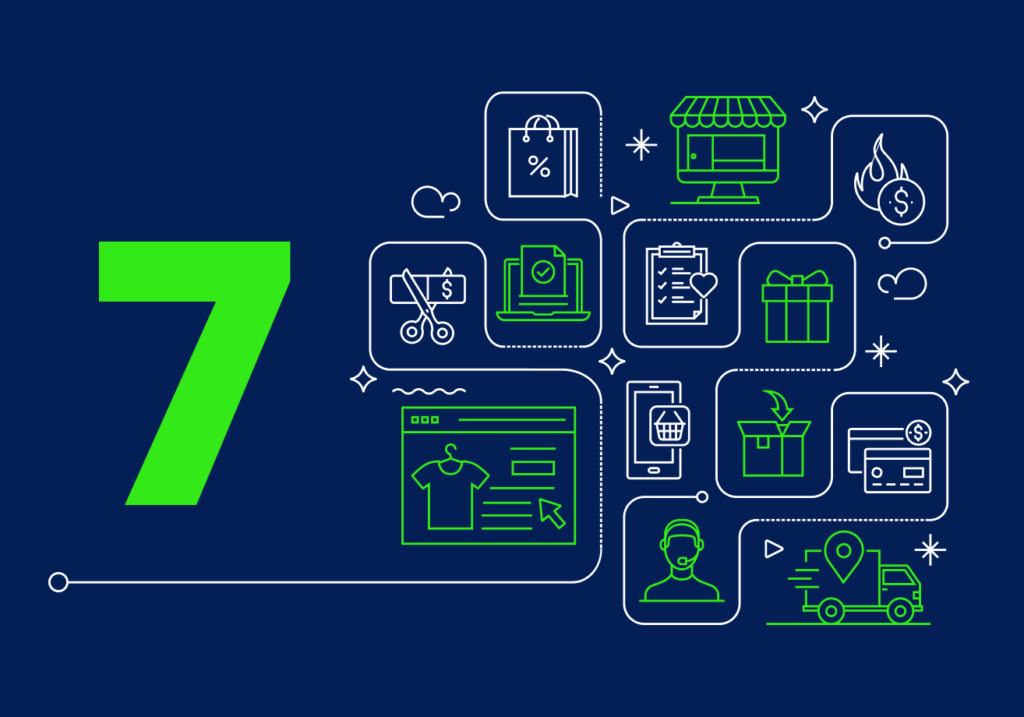One of the continuing challenges in the industry is how to manage the billions of data points surrounding product information—especially as it flows to multiple eCommerce, supply chain and in-store systems. And while some providers have made it the client’s responsibility to find out what needs to be fixed, Syndigo’s two-sided network actually can help—by understanding the needs of both suppliers and recipients.
During the recent Syndication in the Real-Time Economy: A Leadership Approach webinar, the Syndigo team had the chance to answer some of the pressing questions around this complex process. Here are some of the things that participants wanted to know more about, and the live answers given (cleaned up just a bit for readability).
“I filled out my data completely, but it still gets rejected by recipients. How can that be fixed?”
There are a couple of different things that could be happening there. We do see situations where you published, and then requirements are actively changing or retailer system may have some constraints that we didn’t know about yet.
But what often happens is that there may be other things at work. One of the real benefits, I think, of working with Syndigo is those deep relationships that we have with retailers. One of the real benefits to a brand is that high quality content that we’re sending often makes it easier for us to work with a retailer when there is a problem. Sometimes it’s just very clear…You can look at it in the platform (and see that) there’s now a rule in place. And you go, ‘oh, I got to fix this attribute. I republish and I’m good.’
But when it goes a little deeper than that, I would encourage you to reach out to our support teams because we can often help you troubleshoot a problem that might not seem obvious at first glance.
– Laura Creekmore, VP, Operations
“If a retailer is requiring syndicated data, do you guarantee it will be correct?”
That’s a tricky one, isn’t it? It sounds like there’s going to be one perfect definition of what “correct” is. First, I’ll say absolutely, for the data that we’re capturing that goes into our marketplace. We want it to be 100% right.
But for any product, there are going to be some objective things and some subjective things. So an error would be, the brand is misspelled or the ingredients list is wrong, or the health claim is wrong. Those kind of things don’t happen very often.
If you think about the scale of products we’re working at, those errors are few and far between. But when we find them, or if we see one pointed out, we are going to fix that right away.
We do get a lot of folks who ask us about why the information must be in a certain order on that retailer’s website. And those kind of things are a lot more subjective. That kind of thing is not an error, but brands and retailers often have different viewpoints on how data ought to appear. We’re always glad to facilitate those conversations as well.
– Laura Creekmore

What should retailers be doing to make this process easier?
I would say it comes down to communication—clear, consistent and transparent communication. I’d offer that we continue together to do what we’re doing as it relates to the ongoing delivery of our programs and our partnership…but also the joint business planning and business reviews we do that can help us proactively get in front of changes that a retailer may have to their strategy. And then, of course, the requirements that come from a product content perspective.
And then the second part around communication is that the more we can do together to jointly get that message out to the supplier community, the better. It’s often well-received where we have a joint communication that has the retailer’s name associated with it.
It helps us broaden the audience within the brand…people you also may be targeting in terms of who’s working with you, through forums like this one, where we reach out to the supplier, community and others.
– Trevor Martin, SVP, Retail Client Development
This is also where Syndigo plays an important role in the ecosystem, as we sit in that ‘middle ground’ sharing some best practices around the critical sets of data to get an item set up for supply chain, in store, and on the digital shelf…Understanding the ‘must-haves’ and the ‘nice-to-haves’.
Each retailer will have a different view on that, but I think it’s important that when we think about how we bring efficiency, it’s by working with both parties—All of the parties—to say, you know, what do you really need?
So we kind of try to bridge that gap…What we’re trying to do in our system and our platform is build the efficiencies to allow to have that conversation work in a more seamless way.
– Paul Salay, CEO
How can the system know the right data for the right system? Isn’t it still a person behind a desk to flow this data through?
There are definitely a lot of people involved behind the scenes here, but our system really is designed to be that platform. The people involved on the brand side are critical to the process. The people involved here…The people at the retailers, those all matter.
But what we want to do is use this system where the technology does the heavy lifting for all of us. That’s what our system does today. And that piece of it is important because you don’t want to have to continually reconfigure your own systems to try to anticipate all these different changes. When we just talked about the scale at which those changes are happening (we believe) letting the system and the technology do that work brings efficiency for all of us.
– Laura Creekmore

Are there any plans to enable automatic publishing—for example, if an item’s description or ingredients are updated, can these types of updates be synced automatically after initial publication?
If the products are in the Syndigo Marketplace and an update is made to it, then that does go out to retailers automatically. And there is a wide variety across our grocery network, for instance, who receive those updates automatically when a change is made in the Marketplace.
And from a lot of work with brands over a long period of time though, what we’ve really heard is that they really want to have full control over what they’re publishing, right? The brand-created data. And so we’ve designed our system in a way that gives the brand full control over when it’s time to hit Publish.
– Laura Creekmore
But I’ll just add that from the retailer’s side, there are many real situations where a retailer is saying, ‘Look, I don’t want that new product image because I still have all the old images and products in my stores, so I don’t want that new one up on my website.’
Think about different things around the Olympics, or specific seasonality. If you show something online that retailer doesn’t have, or is a different package size, that causes problems.
This is actually specifically designed in the system to give the brand control of the content to make sure that what I’m sending isn’t automatically published. There’s some thought, to control what goes out to what retailer, by whom. So it’s actually designed on purpose that way.
– Paul Salay
How can content creators stay current with retailer requirements and how do we avoid a ‘guess-and-test’ scenario where we develop content, only to find out it doesn’t align to a retailer’s requirements?
You know, this is one I think we have talked about for a long time! It would be delightful if we could magically send an email to everybody who cared about a particular attribute change. But at the scale we’re talking about (more than 25,000 attribute updates and changes a month), it really wouldn’t be practical to send an email to anybody to read and digest those thousands of changes a day.
The way the system works, is that system is always current. So if you’re staying close to the system while you’re designing your content and using that system actively, it’s automatically going to keep you up to date. There’s so much dynamic change occurring that the system being the record is the best way to do it.
– Laura Creekmore

There are different ways to inform, and people want to get information differently. We think of our system as a two-sided network platform…If we have retailers working in the system, and we have brands working in the system, and their agencies and distributors and everybody else working in it, what is the best way to surface up requirements or changes?
The way we’ve addressed that today is through our Content Health indicators to say, ‘Hey, what’s green?’ ‘What’s yellow?’ Or ‘I can’t send this. It’s red.’ So there’s ways that we’re trying to evolve that in that system, but we’re very open to hearing different ways to iterate on this. Again, we’re very client driven, and this is something we are open to solving with (client) ideas.
– Paul Salay
Are there different levels of Syndigo access or if my current company works with Syndigo, are we likely to have access to the level of service outlined in your presentation today?
First, Data Quality is built in. There’s no extra charge for that—you get the benefit of that on every product you publish, any time you’re publishing something through our system, it’s just part of how it works. Honestly, I don’t think we talk about that enough. We think of it as required for the platform, but it really is something unique that we do.
There may be other places where you may or may not subscribe, for example, to our analytics product, or other types of services that we have, but data quality underlies everything you do in our system.
– Laura Creekmore
We built our platform to be able to move data from one party to another in the most efficient way possible. And at the root of that, that data needs to be fit for different purposes—supply chain, to in-store, to eCommerce. But that data has to be accurate. That payload of data needs to have everything…but that’s where we ultimately work to make sure that data is fit for the purpose of who is receiving it.
So it is exactly how we designed our system. It is exactly why we think we’re very differentiated and why we have the largest network of brands and retailers out there.
– Paul Salay










